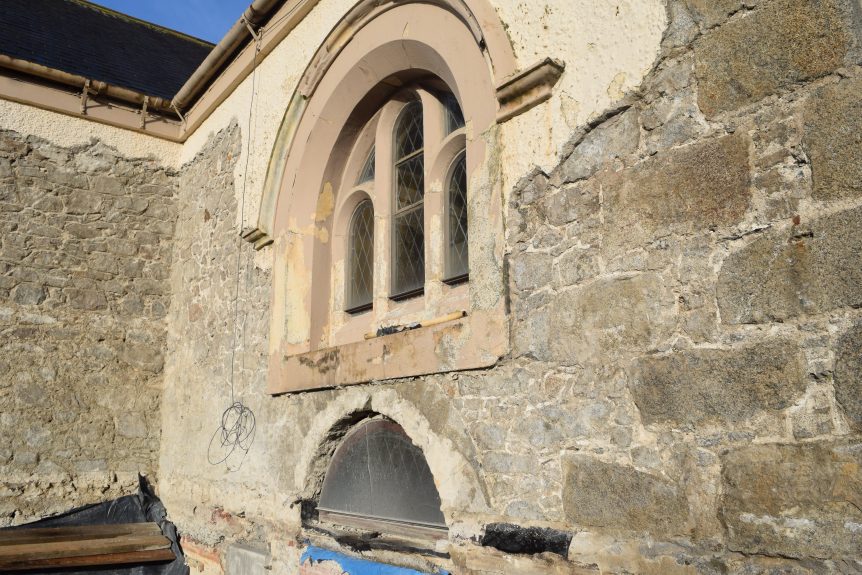Rock of Ages
by Paul McCormack
St Mary’s Church the ‘Old Chapel’ on Chapel Street has been Newry’s Rock of Ages since 1789. Standing proudly at the head of Chapel Street, watching over the graveyard below, the Church is currently undergoing a major restoration and the work to the façade has revealed a tapestry of how Newry society was over 200 years ago. In the last quarter of the 18th century, Ireland was emerging from the shadow of the Penal Laws, the fires of rebellion were burning across Europe, political uncertainty was rife and, ably led by Bishop Matthew Lennon, the parishoners of Newry looking towards a bright future, began to lay the foundations of St Mary’s to replace an old Mass-house. The main walls in the church are built of ‘field stone’ and ‘rubble’ with only the East Wall (facing Chapel Street) made from rough square ‘hammer dressed’ granite and with smaller stones between to ensure break joints for strength. The wall closest to the road being the ‘best dressed’ as would have been the fashion of the time.

The South Window on the choir gallery showing the rough dressed granite corner giving way to the rubble built walls.
Without doubt, every town and city in Ireland has fine examples of buildings or monuments made from granite. As one of the most distinctive of building stones, granite has long been prized for its strength and durability as well as its attractive appearance especially when it was ‘dressed’ granite. You only have to look at the Cathedral of St Patrick & St Colman constructed in 1829 only 40 years after St Mary’s to see how changed times in Ireland brought a new belief and a confidence to build a new cathedral complete with cut, dressed granite – an imposing structure.
However, with the plaster render removed from the walls of St Mary’s, it has revealed a raw beauty of rough stone, uncoursed rubble supported by the prayers, offerings and intentions of worshipers for over 227 years. A structure which in many ways is even more appealing and interesting than other buildings made from expensive cut stone. The round choir window on the east wall evidences how changes have been made to the chapel over the years. The windows of the original chapel, which would have been smaller and rectangular in shape, have undergone renovations over the years, changing the face of St Mary’s. These changes are clearly evidenced with ‘expensive’ red brick being used in these renovations. Red brick wasn’t an option when St Marys’ was originally constructed.

The East Wall of St Mary’s behind the choir gallery with the later addition of the round window supported by red brick
If you get a chance, why not call up to St Mary’s (ensure that you stay outside the security fencing) and have a look at the masonry, marvel at the rubble-built walls, compare the different granite stones and wonder how such a building has stood since 1789, how such flimsy looking walls have stood the tests of time. More importantly why not ask yourself how we, as custodians of the church, today are honoured to carry on the hopes, aspirations and wishes of our forefathers and ensure that the ‘Old Chapel’ stands for many centuries to come?
The hymn Rock of Ages written in 1763 by Augustus Montague-Toplady has the first line ‘Rock of Ages, cleft for me’ which could have been written with St Mary’s in mind. St Mary’s, our rock, our cleft, has provided shelter and protection for many years and generations gone and when the current renovations are complete will continue to do so for many years to come. A church built by people of vision and now being renovated by the descendants of these people with the same shared vision affording parishoners with space to worship God sheltered, cared for and protected by our Rock of Ages.

The bottom of the East Wall of St Mary’s behind the choir gallery showing the dressed stone, quoins and parallel coursing

